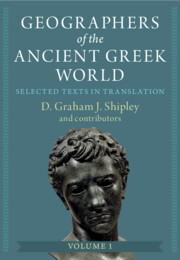Book contents
- Frontmatter
- Dedication
- Epigraph
- Contents
- List of Figures
- List of Maps
- List of Tables
- Contributors
- Preface
- Glossary
- Abbreviations
- Introduction: Greek Geography and Geographers
- Time-line
- Prologue: The Homeric Catalogue of Ships (Iliad, 2. 484–760)
- Part I Archaic Period
- Part II Classical Period
- Part III Hellenistic Period
- 9 Dikaiarchos of Messana
- 10 Timosthenes of Rhodes
- 11 Herakleides Kritikos
- 12 Eratosthenes of Kyrene
- 13 Mnaseas of Patara
- 14 Skymnos of Chios
- 15 Agatharchides of Knidos, On the Erythraian Sea
- 16 Hipparchos of Nikaia
- 17 The Nikomedean Periodos [‘Pseudo-Skymnos’]
- 18 Artemidoros of Ephesos
- 19 Poseidonios of Apameia
- 20 Dionysios son of Kalliphon
17 - The Nikomedean Periodos [‘Pseudo-Skymnos’]
from Part III - Hellenistic Period
Published online by Cambridge University Press: 25 March 2024
- Frontmatter
- Dedication
- Epigraph
- Contents
- List of Figures
- List of Maps
- List of Tables
- Contributors
- Preface
- Glossary
- Abbreviations
- Introduction: Greek Geography and Geographers
- Time-line
- Prologue: The Homeric Catalogue of Ships (Iliad, 2. 484–760)
- Part I Archaic Period
- Part II Classical Period
- Part III Hellenistic Period
- 9 Dikaiarchos of Messana
- 10 Timosthenes of Rhodes
- 11 Herakleides Kritikos
- 12 Eratosthenes of Kyrene
- 13 Mnaseas of Patara
- 14 Skymnos of Chios
- 15 Agatharchides of Knidos, On the Erythraian Sea
- 16 Hipparchos of Nikaia
- 17 The Nikomedean Periodos [‘Pseudo-Skymnos’]
- 18 Artemidoros of Ephesos
- 19 Poseidonios of Apameia
- 20 Dionysios son of Kalliphon
Summary
This chapter presents a new, annotated translation (approximating English pentameters) of the anonymous iambic poem sometimes called (without any evidence) ‘Pseudo-Skymnos’ but here ‘the Nikomedean Periodos’ (127/6–74 BC). The surviving, first part of the poem, whose ‘journey’ is arranged clockwise from the western Mediterranean, takes us a little way into the Black Sea. For the next part, dealing with the Black Sea, we have 38 fragments, all but one of which are from the Pseudo-Arrianic Circumnavigation of the Black Sea (Chapter 36 of this volume). Of the remainder we have no trace. The chapter introduction revisits the controversy about the identity of the poem’s author: possibly Apollodoros of Athens, though that suggestion is less secure than has been thought (despite the claimed reading of Apollodoros’ name in a damaged passage of the manuscript); possibly the otherwise unknown Pausanias of Damascus (if he existed). The poem, dedicated to a king Nikomedes of Bithynia, displays the influence of Ephoros and Eratosthenes, as well as responding to Homer. Though innovative, the work had little influence (though the late antique Euxine, Chapter 36 below, repeatedly quotes from it) but remains an important source for scholars investigating Greek colonial foundations in the West. A new map indicates the ‘route’ followed in the poem.
Keywords
- Type
- Chapter
- Information
- Geographers of the Ancient Greek WorldSelected Texts in Translation, pp. 466 - 500Publisher: Cambridge University PressPrint publication year: 2024



